Integrated Quantile Mapping and Spatial Clustering for Robust Bias Correction of Satellite Precipitation in Data-Sparse Regions
Abstract
1. Introduction
2. Materials and Methods
2.1. Data Collection
2.2. Data Preprocessing
- Standardization of Date Formats, Temporal Resolution, and Spatial Coordinates: To ensure credible comparison, we selected an interval that both had satellite and in situ records, with continuous-record stations covering the 2000–2014 interval to achieve best spatial coverage and data duration. The geographical position (latitude and longitude) of the stations was used to identify corresponding satellite pixels by rounding to the resolution of the grid of the satellite. Spatial filtering was accomplished by selecting the closest satellite grid points to the sites of each rain gauge via nearest-neighbor interpolation. Temporal filtering involved aligning satellite data timestamps precisely with the dates of the in situ observations, without interpolation or aggregation. This alignment created a good one-to-one correspondence in space and time and enabled meaningful integration and comparison later for bias correction and accuracy assessment. The filtered satellite data Dfiltered = Dsat(ti,xj), where ti denotes time and xj denotes position, was matched with the corresponding ground-based data Dground.
- Merging in situ and satellite data: After filtering, the pre-processed in situ data are merged with the corresponding filtered satellite data to create a comprehensive dataset. This merged dataset combines the high spatial coverage of satellite observations with the local accuracy of ground-based measurements. The merging process aligns data points in both space and time, ensuring that each in situ measurement corresponds to the nearest satellite pixel on the same date. In cases where multiple satellite values fall within the vicinity of a single in situ location, the closest value is selected to avoid duplication. Symbolically, this combined dataset can be expressed as:
- 3.
- Outlier Detection: To identify exceptionally high precipitation events, we applied quantile analysis. In this study, outliers are defined as precipitation values above the 95th percentile of the distribution. These points represent extreme events of hydrological significance rather than errors or measurement mistakes. The outliers were flagged but not removed from the dataset, as the primary aim of this study is to characterize rare, high-magnitude precipitation events that may hold hydrological importance beyond the general pattern. This approach ensures that extreme events are clearly identified and available for further analysis in subsequent steps.
2.3. Temporal Trend Analysis
2.4. Clustering Analysis
2.5. Quantile Mapping
2.6. Model Training and Analysis
2.7. Trade-Off Analysis
3. Results
4. Implications for Satellite Precipitation Estimation
5. Discussion
- i.
- Two-tier approach: Combines clustering and quantile mapping for enhanced precipitation measurement accuracy.
- ii.
- Spatial variability: Clustering ensures localized patterns are captured.
- iii.
- Extreme events: Improves detection of both mean and extreme precipitation.
- iv.
- Novel bias correction: Integrates clustering to refine remote sensing data.
- v.
- Scalability: Applicable to diverse geographic and climatic regions.
- vi.
- Rain gauge validation: Highlights areas of reliable satellite data.
6. Conclusions
Author Contributions
Funding
Institutional Review Board Statement
Informed Consent Statement
Data Availability Statement
Acknowledgments
Conflicts of Interest
References
- Najmaddin, P.M.; Whelan, M.J.; Balzter, H. Application of satellite-based precipitation estimates to rainfall-runoff modelling in a data-scarce semi-arid catchment. Climate 2017, 5, 32. [Google Scholar] [CrossRef]
- Levizzani, V.; Cattani, E. Satellite remote sensing of precipitation and the terrestrial water cycle in a changing climate. Remote Sens. 2019, 11, 2301. [Google Scholar] [CrossRef]
- Boluwade, A. Spatial-temporal assessment of satellite-based rainfall estimates in different precipitation regimes in water-scarce and data-sparse regions. Atmosphere 2020, 11, 901. [Google Scholar] [CrossRef]
- Abegeja, D. The application of satellite sensors, current state of utilization, and sources of remote sensing dataset in hydrology for water resource management. J. Water Health 2024, 22, 1162–1179. [Google Scholar] [CrossRef]
- Balsamo, G.; Agustì-Parareda, A.; Albergel, C.; Arduini, G.; Beljaars, A.; Bidlot, J.; Blyth, E.; Bousserez, N.; Boussetta, S.; Brown, A.; et al. Satellite and in situ observations for advancing global Earth surface modelling: A review. Remote Sens. 2018, 10, 2038. [Google Scholar] [CrossRef]
- Ullah, W.; Wang, G.; Ali, G.; Tawia Hagan, D.F.; Bhatti, A.S.; Lou, D. Comparing multiple precipitation products against in-situ observations over different climate regions of Pakistan. Remote Sens. 2019, 11, 628. [Google Scholar] [CrossRef]
- Foster, T.; Mieno, T.; Brozović, N. Satellite-based monitoring of irrigation water use: Assessing measurement errors and their implications for agricultural water management policy. Water Resour. Res. 2020, 56, e2020WR028378. [Google Scholar] [CrossRef]
- Liu, S.; Wu, Y.; Xu, G.; Cheng, S.; Zhong, Y.; Zhang, Y. Characterizing the 2022 extreme drought event over the Poyang lake basin using multiple satellite remote sensing observations and in situ data. Remote Sens. 2023, 15, 5125. [Google Scholar] [CrossRef]
- Park, J.; Jeong, H.; Lee, J. National disaster management and monitoring using satellite remote sensing and geo-information. Korean J. Remote Sens. 2024, 40, 813–832. [Google Scholar] [CrossRef]
- Dubovik, O.; Schuster, G.L.; Xu, F.; Hu, Y.; Bösch, H.; Landgraf, J.; Li, Z. Grand challenges in satellite remote sensing. Front. Remote Sens. 2021, 2, 619818. [Google Scholar] [CrossRef]
- Humphrey, V.; Rodell, M.; Eicker, A. Using satellite-based terrestrial water storage data: A review. Surv. Geophys. 2023, 44, 1489–1517. [Google Scholar] [CrossRef] [PubMed]
- Loew, A.; Bell, W.; Brocca, L.; Bulgin, C.E.; Burdanowitz, J.; Calbet, X.; Donner, R.V.; Ghent, D.; Gruber, A.; Kaminski, T.; et al. Validation practices for satellite-based Earth observation data across communities. Rev. Geophys. 2017, 55, 779–817. [Google Scholar] [CrossRef]
- Jiang, D.; Wang, K. The role of satellite-based remote sensing in improving simulated streamflow: A review. Water 2019, 11, 1615. [Google Scholar] [CrossRef]
- Akinyemi, D.F.; Ayanlade, O.S.; Nwaezeigwe, J.O.; Ayanlade, A. A comparison of the accuracy of multi-satellite precipitation estimation and ground meteorological records over Southwestern Nigeria. Remote Sens. Earth Syst. Sci. 2020, 3, 1–2. [Google Scholar] [CrossRef]
- Karaman, Ç.H. Improving the Accuracy of Satellite-Based Near-Surface Air Temperature and Precipitation Products. Doctoral Dissertation, Middle East Technical University, Ankara, Turkey.
- Pan, M.; Li, H.; Wood, E. Assessing the skill of satellite-based precipitation estimates in hydrologic applications. Water Resour. Res. 2010, 46, W09535. [Google Scholar] [CrossRef]
- Maggioni, V.; Massari, C. On the performance of satellite precipitation products in riverine flood modeling: A review. J. Hydrol. 2018, 558, 214–224. [Google Scholar] [CrossRef]
- Hinge, G.; Hamouda, M.A.; Long, D.; Mohamed, M.M. Hydrologic utility of satellite precipitation products in flood prediction: A meta-data analysis and lessons learnt. J. Hydrol. 2022, 612, 128103. [Google Scholar] [CrossRef]
- Hoffmann, P.; Katzfey, J.J.; McGregor, J.L.; Thatcher, M. Bias and variance correction of sea surface temperatures used for dynamical downscaling. J. Geophys. Res. Atmos. 2016, 121, 877–894. [Google Scholar] [CrossRef]
- Akhter, J.; Sarkar, S.; Choudhury, R.R.; Das, L.; Midya, S.K. Performance analysis of IMDAA and ERA5 reanalysis in reproducing monsoon precipitation extremes over Eastern India. Theor. Appl. Climatol. 2025, 156, 371. [Google Scholar] [CrossRef]
- Nguyen, N.Y.; Anh, T.N.; Nguyen, H.D.; Dang, D.K. Quantile mapping technique for enhancing satellite-derived precipitation data in hydrological modelling: A case study of the Lam River Basin, Vietnam. J. Hydroinform. 2024, 26, 2026–2044. [Google Scholar] [CrossRef]
- Eekhout, J.P. Using quantile mapping and random forest for bias-correction of high-resolution reanalysis precipitation data and CMIP6 climate projections over Iran. Int. J. Climatol. 2024, 44, 4495–4514. [Google Scholar]
- Duvan, A.; Aktürk, G.; Yıldız, O. Assessing spatiotemporal characteristics of meteorological droughts in the Marmara Basin using HadGEM2-ES global climate model data. Environ. Monit. Assess. 2025, 197, 436. [Google Scholar] [CrossRef] [PubMed]
- Kaur, I.; Hüser, I.; Zhang, T.; Gehrke, B.; Kaiser, J.W. Correcting swath-dependent bias of MODIS FRP observations with quantile mapping. Remote Sens. 2019, 11, 1205. [Google Scholar] [CrossRef]
- Burnama, N.S.; Rohmat, F.I.; Farid, M.; Wijayasari, W. Utilization of quantile mapping method using cumulative distribution function (CDF) to calibrated satellite rainfall GSMaP in Majalaya watershed. In IOP Conference Series: Earth and Environmental Science, Proceedings of the 8th International Conference on Climate Change (8TH-ICCC), Bangkok, Thailand, 17 November 2022; IOP Publishing: Bristol, UK, 2023; Volume 1165, p. 012006. [Google Scholar]
- Koutsouris, A.J.; Seibert, J.; Lyon, S.W. Utilization of global precipitation datasets in data limited regions: A case study of Kilombero Valley, Tanzania. Atmosphere 2017, 8, 246. [Google Scholar] [CrossRef]
- Zhang, Y.; Ye, A.; Analui, B.; Nguyen, P.; Sorooshian, S.; Hsu, K.; Wang, Y. Comparing quantile regression forest and mixture density long short-term memory models for probabilistic post-processing of satellite precipitation-driven streamflow simulations. Hydrol. Earth Syst. Sci. 2023, 27, 4529–4550. [Google Scholar] [CrossRef]
- Ringard, J.; Seyler, F.; Linguet, L. A quantile mapping bias correction method based on hydroclimatic classification of the Guiana shield. Sensors 2017, 17, 1413. [Google Scholar] [CrossRef]
- Ayugi, B.; Tan, G.; Ruoyun, N.; Babaousmail, H.; Ojara, M.; Wido, H.; Mumo, L.; Ngoma, N.H.; Nooni, I.K.; Ongoma, V. Quantile mapping bias correction on rossby centre regional climate models for precipitation analysis over Kenya, East Africa. Water 2020, 12, 801. [Google Scholar] [CrossRef]
- Charoensuk, T.; Luchner, J.; Balbarini, N.; Sisomphon, P.; Bauer-Gottwein, P. Enhancing the capabilities of the Chao Phraya forecasting system through the integration of pre-processed numerical weather forecasts. J. Hydrol. Reg. Stud. 2024, 52, 101737. [Google Scholar] [CrossRef]
- Hassanzadeh, E.; Nazemi, A.; Adamowski, J.; Nguyen, T.H.; Van-Nguyen, V.T. Quantile-based downscaling of rainfall extremes: Notes on methodological functionality, associated uncertainty and application in practice. Adv. Water Resour. 2019, 131, 103371. [Google Scholar] [CrossRef]
- Holthuijzen, M.; Beckage, B.; Clemins, P.J.; Higdon, D.; Winter, J.M. Robust bias-correction of precipitation extremes using a novel hybrid empirical quantile-mapping method: Advantages of a linear correction for extremes. Theor. Appl. Climatol. 2022, 149, 863–882. [Google Scholar] [CrossRef]
- Pasche, O.C.; Engelke, S. Neural networks for extreme quantile regression with an application to forecasting of flood risk. Ann. Appl. Stat. 2024, 18, 2818–2839. [Google Scholar] [CrossRef]
- Huffman, G.J.; Behrangi, A.; Bolvin, D.T.; Nelkin, E.J. GPCP Version 3.1 Satellite-Gauge (SG) Combined Precipitation Data Set; NASA GES DISC: Greenbelt, MD, USA, 2020. [Google Scholar]
- Mann, H.B. Nonparametric tests against trend. Econom. J. Econom. Soc. 1945, 13, 245–259. [Google Scholar] [CrossRef]
- Kendall, M.G. Rank Correlation Methods; Charles Griffin & Company Ltd.: London, UK, 1948. [Google Scholar]
- Harrigan, S.; Murphy, C.; Hall, J.; Wilby, R.L.; Sweeney, J. Attribution of detected changes in streamflow using multiple working hypotheses. Hydrol. Earth Syst. Sci. 2014, 18, 1935–1952. [Google Scholar] [CrossRef]
- Yue, S.; Wang, C. The Mann-Kendall test modified by effective sample size to detect trend in serially correlated hydrological series. Water Resour. Manag. 2004, 18, 201–218. [Google Scholar] [CrossRef]
- Lund, B.; Ma, J. A review of cluster analysis techniques and their uses in library and information science research: K-means and k-medoids clustering. Perform. Meas. Metr. 2021, 22, 161–173. [Google Scholar] [CrossRef]
- Ikotun, A.M.; Ezugwu, A.E.; Abualigah, L.; Abuhaija, B.; Heming, J. K-means clustering algorithms: A comprehensive review, variants analysis, and advances in the era of big data. Inf. Sci. 2023, 622, 178–210. [Google Scholar] [CrossRef]
- Fränti, P.; Sieranoja, S. How much can k-means be improved by using better initialization and repeats? Pattern Recognit. 2019, 93, 95–112. [Google Scholar] [CrossRef]
- Shafi, I.; Chaudhry, M.; Montero, E.C.; Alvarado, E.S.; Diez, I.D.; Samad, M.A.; Ashraf, I. A Review of Approaches for Rapid Data Clustering: Challenges, Opportunities and Future Directions. IEEE Access 2024, 12, 138086–138120. [Google Scholar] [CrossRef]
- Bhatia, M.S. Data clustering with modified K-means algorithm. In Proceedings of the 2011 International Conference on Recent Trends in Information Technology (ICRTIT), Chennai, India, 3–5 June 2011; pp. 717–721. [Google Scholar]
- Wani, A.A. Comprehensive analysis of clustering algorithms: Exploring limitations and innovative solutions. PeerJ Comput. Sci. 2024, 10, e2286. [Google Scholar] [CrossRef] [PubMed]
- Il Idrissi, M.; Bousquet, N.; Gamboa, F.; Iooss, B.; Loubes, J.M. Quantile-constrained Wasserstein projections for robust interpretability of numerical and machine learning models. Electron. J. Stat. 2024, 18, 2721–2770. [Google Scholar] [CrossRef]
- Cannon, A.J. Multivariate quantile mapping bias correction: An N-dimensional probability density function transform for climate model simulations of multiple variables. Clim. Dyn. 2018, 50, 31–49. [Google Scholar] [CrossRef]
- Devi, U.; Shekhar, M.S.; Singh, G.P.; Rao, N.N.; Bhatt, U.S. Methodological application of quantile mapping to generate precipitation data over Northwest Himalaya. Int. J. Climatol. 2019, 39, 3160–3170. [Google Scholar] [CrossRef]
- Robertson, D.E.; Chiew, F.H.; Potter, N. Adapting rainfall bias-corrections to improve hydrological simulations generated from climate model forcings. J. Hydrol. 2023, 619, 129322. [Google Scholar] [CrossRef]
- Guo, Q.; Chen, J.; Zhang, X.; Shen, M.; Chen, H.; Guo, S. A new two-stage multivariate quantile mapping method for bias correcting climate model outputs. Clim. Dyn. 2019, 53, 3603–3623. [Google Scholar] [CrossRef]
- Dong, N.; Hao, H.; Yang, M.; Wei, J.; Xu, S.; Kunstmann, H. Deep learning based sub-seasonal precipitation and streamflow forecasting over the source region of the Yangtze River. Hydrol. Earth Syst. Sci. Discuss. 2024, 2024, 1–26. [Google Scholar] [CrossRef]
- Dinh, T.L.; Aires, F. Revisiting the bias correction of climate models for impact studies. Clim. Change 2023, 176, 140. [Google Scholar] [CrossRef]
- Ma, F.; Ji, C.; Wang, J.; Sun, W.; Palazoglu, A. Soft Sensor Modeling Method Considering Higher-Order Moments of Prediction Residuals. Processes 2024, 12, 676. [Google Scholar] [CrossRef]
- Enayati, M.; Bozorg-Haddad, O.; Bazrafshan, J.; Hejabi, S.; Chu, X. Bias correction capabilities of quantile mapping methods for rainfall and temperature variables. J. Water Clim. Change 2021, 12, 401–419. [Google Scholar] [CrossRef]
- Sandfeld, S. Exploratory Data Analysis. In Materials Data Science: Introduction to Data Mining, Machine Learning, and Data-Driven Predictions for Materials Science and Engineering; Springer International Publishing: Cham, Switzerland, 17 November 2023; pp. 179–206. [Google Scholar]
- Zhang, J.; Xie, J.; Liu, C. Probabilistic Inference: Test and Multiple Tests. Int. J. Approx. Reason. 2014, 55, 654–665. [Google Scholar]
- Knoben, W.J.; Freer, J.E.; Woods, R.A. Inherent benchmark or not? Comparing Nash–Sutcliffe and Kling–Gupta efficiency scores. Hydrol. Earth Syst. Sci. 2019, 23, 4323–4331. [Google Scholar] [CrossRef]
- Duc, L.; Sawada, Y. A signal-processing-based interpretation of the Nash–Sutcliffe efficiency. Hydrol. Earth Syst. Sci. 2023, 27, 1827–1839. [Google Scholar] [CrossRef]
- Das, B.; Jain, S.; Singh, S.; Thakur, P. Evaluation of multisite performance of SWAT model in the Gomti River Basin, India. Appl. Water Sci. 2019, 9, 134. [Google Scholar] [CrossRef]
- Vrugt, J.A.; de Oliveira, D.Y. Confidence intervals of the Kling-Gupta efficiency. J. Hydrol. 2022, 612, 127968. [Google Scholar] [CrossRef]
- Chakri, A.; Laftouhi, N.E.; Zouhri, L.; Ibouh, H.; Ibnoussina, M. Assessment of Satellite and Reanalysis Precipitation Data Using Statistical and Wavelet Analysis in Semi-Arid, Morocco. Water 2025, 17, 1714. [Google Scholar] [CrossRef]
- Moriasi, D.N.; Arnold, J.G.; Van Liew, M.W.; Bingner, R.L.; Harmel, R.D.; Veith, T.L. Model evaluation guidelines for systematic quantification of accuracy in watershed simulations. Trans. ASABE 2007, 50, 885–900. [Google Scholar] [CrossRef]
- Bennett, N.D.; Croke, B.F.; Guariso, G.; Guillaume, J.H.; Hamilton, S.H.; Jakeman, A.J.; Marsili-Libelli, S.; Newham, L.T.; Norton, J.P.; Perrin, C.; et al. Characterising performance of environmental models. Environ. Model. Softw. 2013, 40, 1–20. [Google Scholar] [CrossRef]
- Martin, R.F. General Deming regression for estimating systematic bias and its confidence interval in method-comparison studies. Clin. Chem. 2000, 46, 100–104. [Google Scholar] [CrossRef]
- Song, Z.; Bai, W.; Zhang, Y.; Wang, Y.; Xu, X.; Xin, J. Evaluation of Satellite-Derived Atmospheric Temperature and Humidity Profiles and Their Application as Precursors to Severe Convective Precipitation. Remote Sens. 2024, 16, 4638. [Google Scholar] [CrossRef]
- Minh, D.; Wang, H.X.; Li, Y.F.; Nguyen, T.N. Explainable artificial intelligence: A comprehensive review. Artif. Intell. Rev. 2022, 55, 3503–3568. [Google Scholar] [CrossRef]
- Roe, K.D.; Jawa, V.; Zhang, X.; Chute, C.G.; Epstein, J.A.; Matelsky, J.; Shpitser, I.; Taylor, C.O. Feature engineering with clinical expert knowledge: A case study assessment of machine learning model complexity and performance. PLoS ONE 2020, 15, e0231300. [Google Scholar] [CrossRef]
- Myung, I.J. The importance of complexity in model selection. J. Math. Psychol. 2000, 44, 190–204. [Google Scholar] [CrossRef]
- Bossaerts, P.; Murawski, C. Computational complexity and human decision-making. Trends Cogn. Sci. 2017, 21, 917–929. [Google Scholar] [CrossRef] [PubMed]
- Katiraie-Boroujerdy, P.S.; Rahnamay Naeini, M.; Akbari Asanjan, A.; Chavoshian, A.; Hsu, K.L.; Sorooshian, S. Bias correction of satellite-based precipitation estimations using quantile mapping approach in different climate regions of Iran. Remote Sens. 2020, 12, 2102. [Google Scholar] [CrossRef]
- Mirones, Ó.; Bedia, J.; Herrera, S.; Iturbide, M.; Baño Medina, J. Refining remote sensing precipitation datasets in the South Pacific with an adaptive multi-method calibration approach. Hydrol. Earth Syst. Sci. 2025, 29, 799–822. [Google Scholar] [CrossRef]
- Rajulapati, C.R.; Papalexiou, S.M. Precipitation bias correction: A novel semi-parametric quantile mapping method. Earth Space Sci. 2023, 10, e2023EA002823. [Google Scholar] [CrossRef]
- Li, X.; Wu, H.; Nanding, N.; Chen, S.; Hu, Y.; Li, L. Statistical bias correction of precipitation forecasts based on quantile mapping on the sub-seasonal to seasonal scale. Remote Sens. 2023, 15, 1743. [Google Scholar] [CrossRef]
- Tani, S.; Gobiet, A. Quantile mapping for improving precipitation extremes from regional climate models. J. Agrometeorol. 2019, 21, 434. [Google Scholar] [CrossRef]
- Cannon, A.J.; Sobie, S.R.; Murdock, T.Q. Bias correction of GCM precipitation by quantile mapping: How well do methods preserve changes in quantiles and extremes? J. Clim. 2015, 28, 6938–6959. [Google Scholar] [CrossRef]
- Lyra, G.B.; Oliveira-Junior, J.F.; Zeri, M. Cluster analysis applied to the spatial and temporal variability of monthly rainfall in Alagoas state, Northeast of Brazil. Int. J. Climatol. 2014, 34, 3546–3558. [Google Scholar] [CrossRef]
- Sheffield, J.; Wood, E.F.; Pan, M.; Beck, H.; Coccia, G.; Serrat-Capdevila, A.; Verbist, K.J.W.R.R. Satellite remote sensing for water resources management: Potential for supporting sustainable development in data-poor regions. Water Resour. Res. 2018, 54, 9724–9758. [Google Scholar] [CrossRef]
- Mullick, M.R.A.; Khattak, M.S.; Haq, Z.U. Considering environmental flow for water resources management in South Asia: Current status and challenges. J. Eng. Appl. Sci. 2012, 31, 37–44. [Google Scholar]
- Droogers, P.; Immerzeel, W.W.; Terink, W.; Hoogeveen, J.; Bierkens, M.F.P.; Van Beek, L.P.H.; Debele, B. Water resources trends in Middle East and North Africa towards 2050. Hydrol. Earth Syst. Sci. 2012, 16, 3101–3114. [Google Scholar] [CrossRef]
- World Health Organization; United Nations Children’s Fund. State of the World’s Drinking Water: An Urgent Call to Action to Accelerate Progress on Ensuring Safe Drinking Water for All; World Health Organization: Geneva, Switzerland, 2022. [Google Scholar]
- Rogers, D.; Tsirkunov, V. Costs And benefits of Early Warning Systems; Global assessment Rep; World Bank: Washington, DC, USA, 2011. [Google Scholar]
- Perera, D.; Seidou, O.; Agnihotri, J.; Rasmy, M.; Smakhtin, V.; Coulibaly, P.; Mehmood, H. Flood Early Warning Systems: A Review of Benefits, Challenges and Prospects; UNU-INWEH: Hamilton, ON, Canada, 2019. [Google Scholar]
- Van den Homberg, M.; Susha, I. Characterizing data ecosystems to support official statistics with open mapping data for reporting on sustainable development goals. ISPRS Int. J. Geo-Inf. 2018, 7, 456. [Google Scholar] [CrossRef]
- Alexopoulos, A.; Koutras, K.; Ali, S.B.; Puccio, S.; Carella, A.; Ottaviano, R.; Kalogeras, A. Complementary use of ground-based proximal sensing and airborne/spaceborne remote sensing techniques in precision agriculture: A systematic review. Agronomy 2023, 13, 1942. [Google Scholar] [CrossRef]
- Passow, C.; Donner, R.V. Regression-based distribution mapping for bias correction of climate model outputs using linear quantile regression. Stoch. Environ. Res. Risk Assess. 2020, 34, 87–102. [Google Scholar] [CrossRef]
- Wolf, K.; Bellouin, N.; Boucher, O.; Rohs, S.; Li, Y. Correction of ERA5 temperature and relative humidity biases by bivariate quantile mapping for contrail formation analysis. Atmos. Chem. Phys. 2025, 25, 157–181. [Google Scholar] [CrossRef]
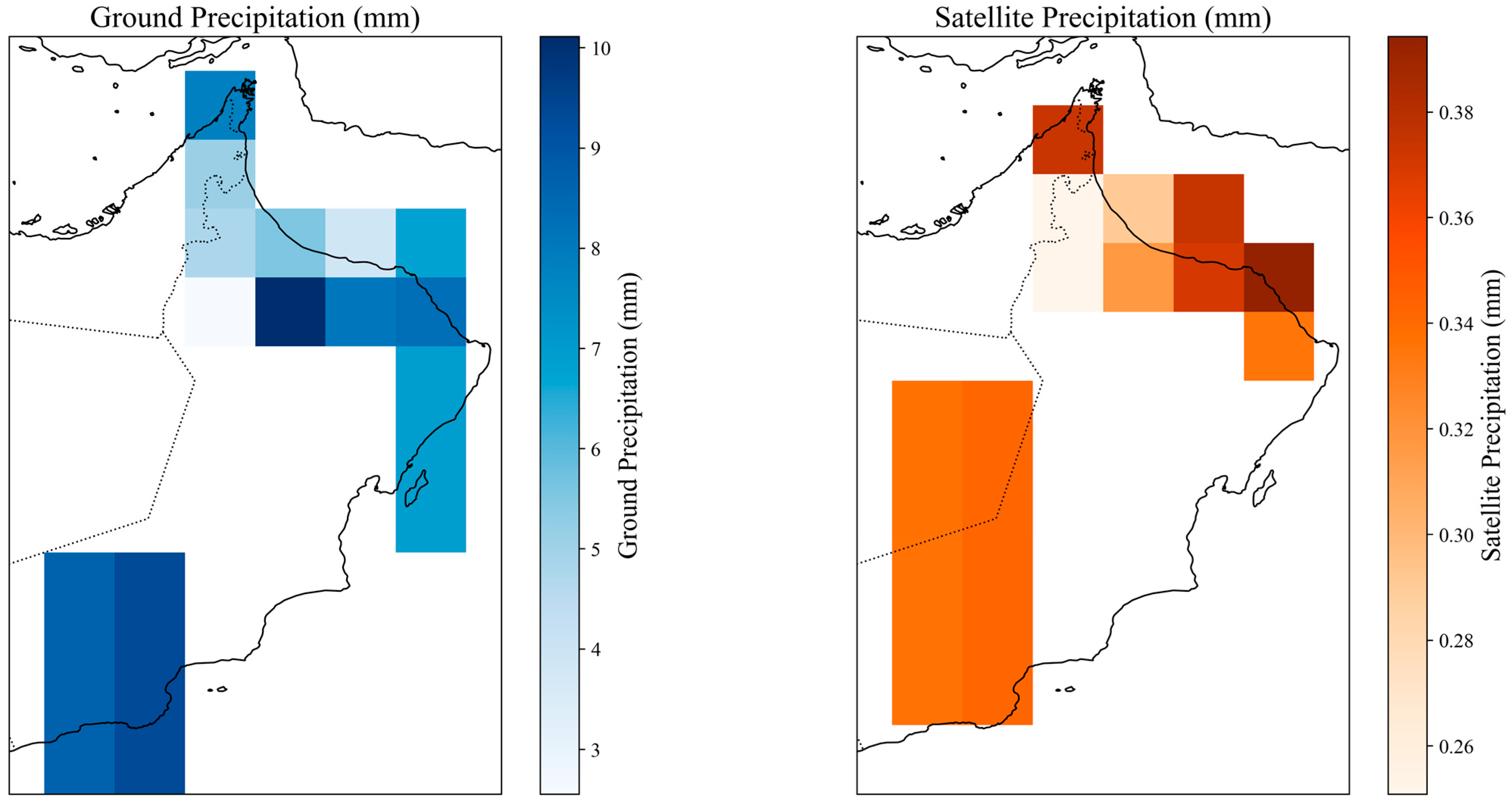
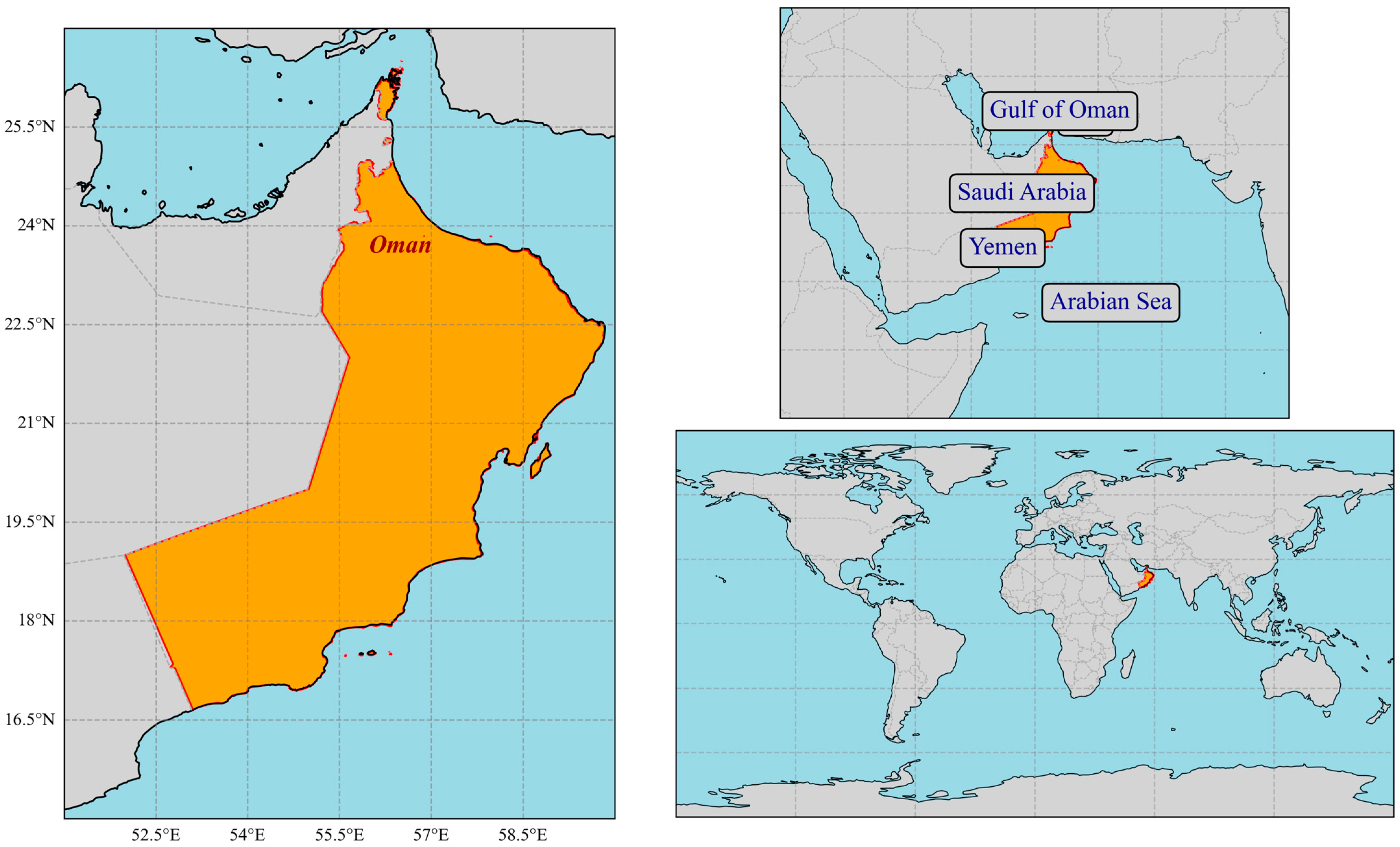
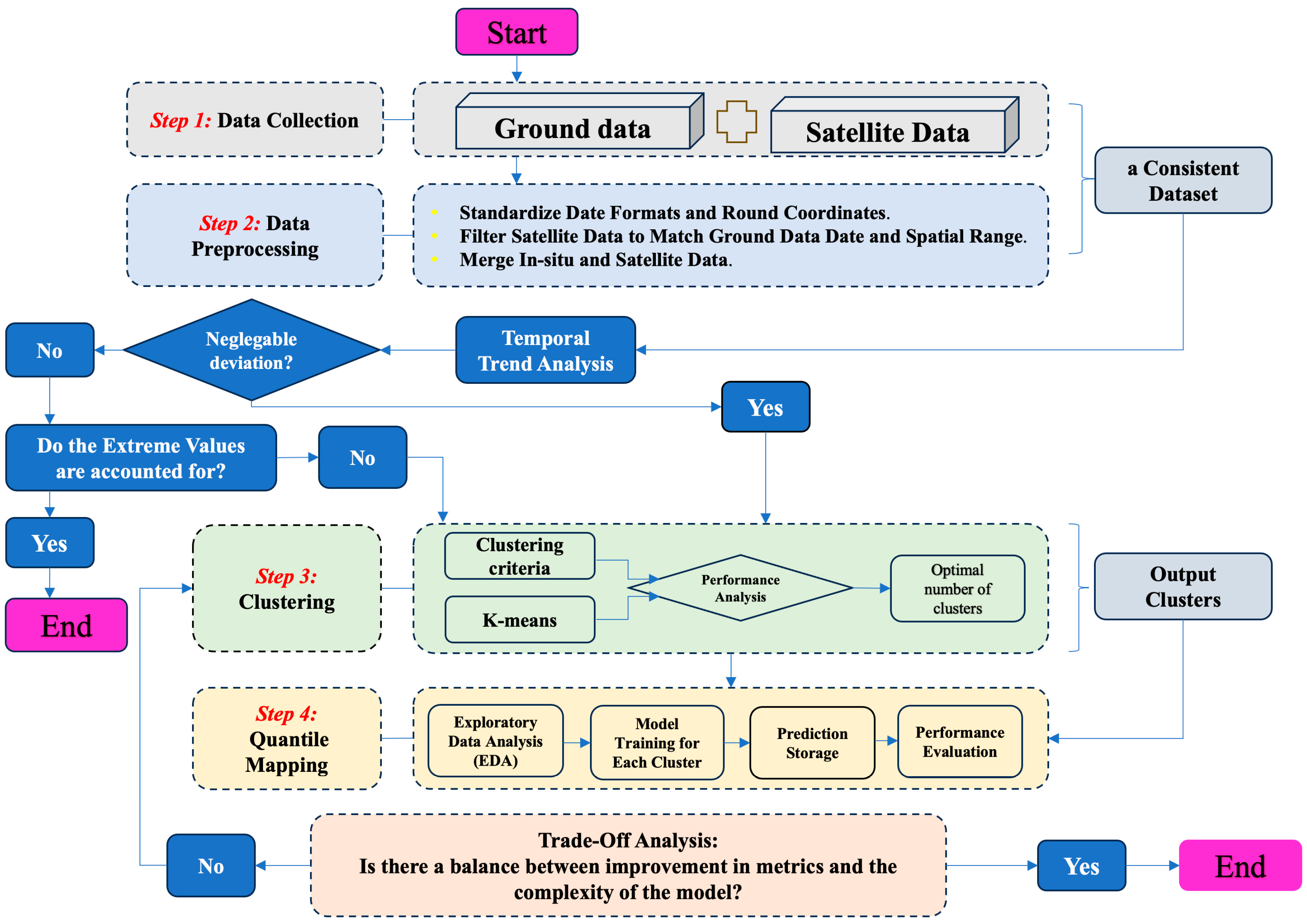
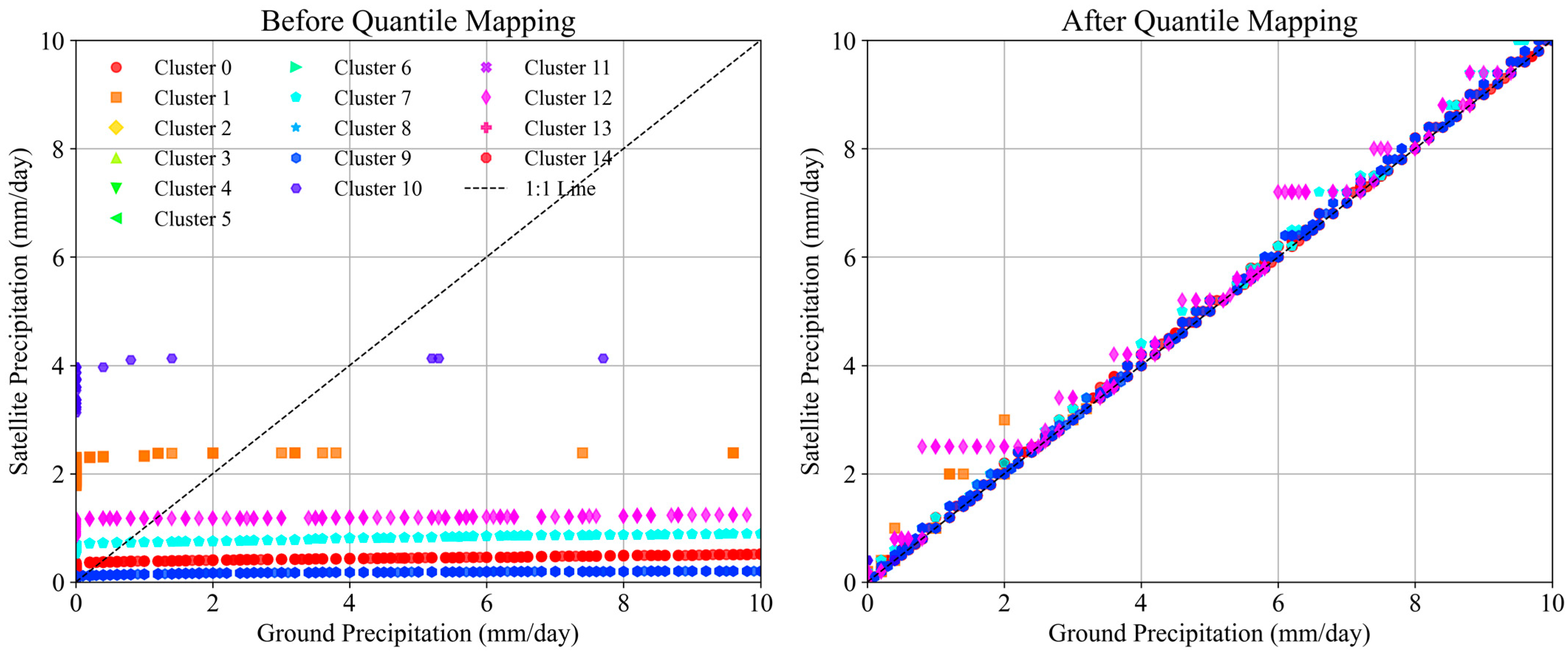
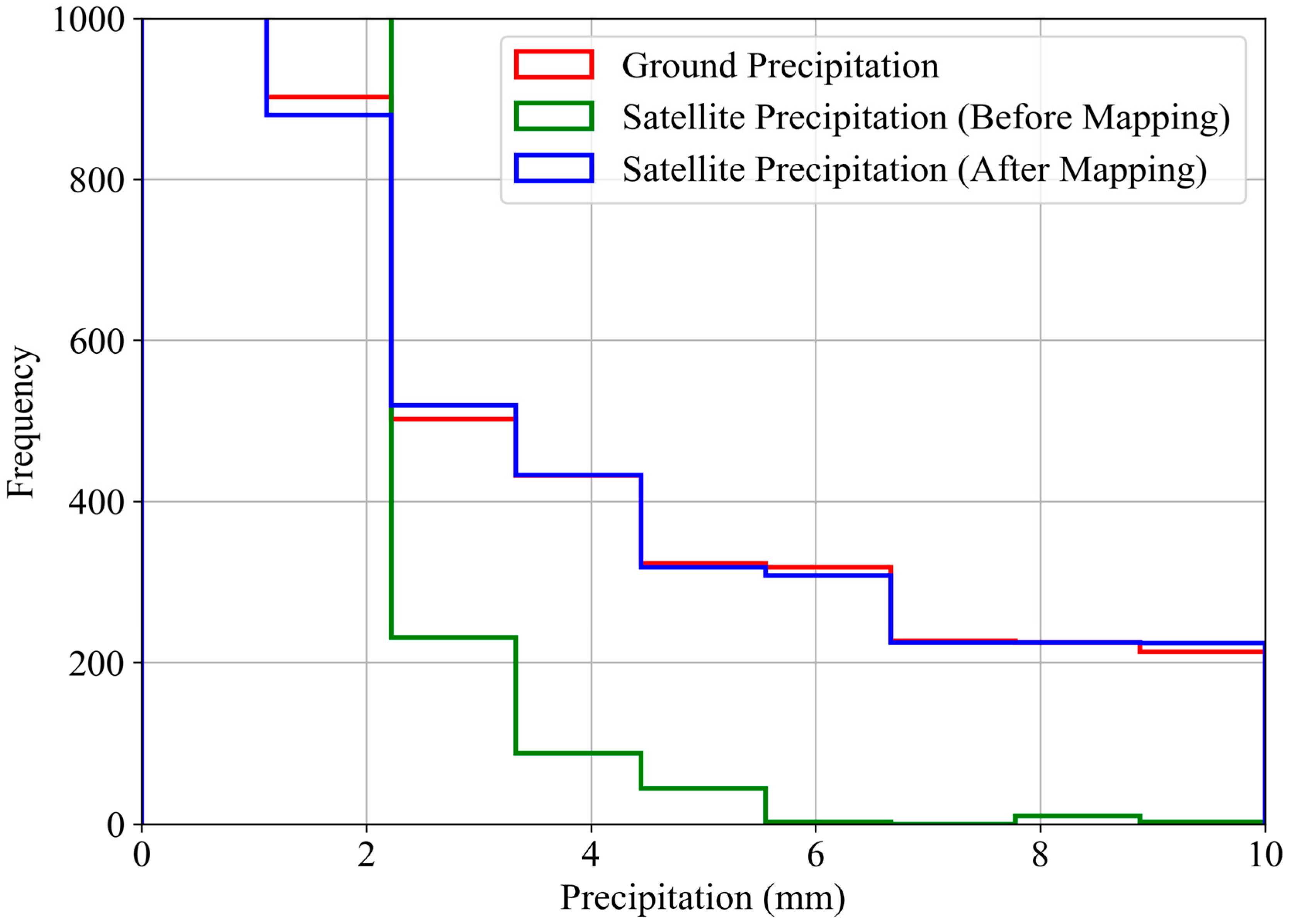
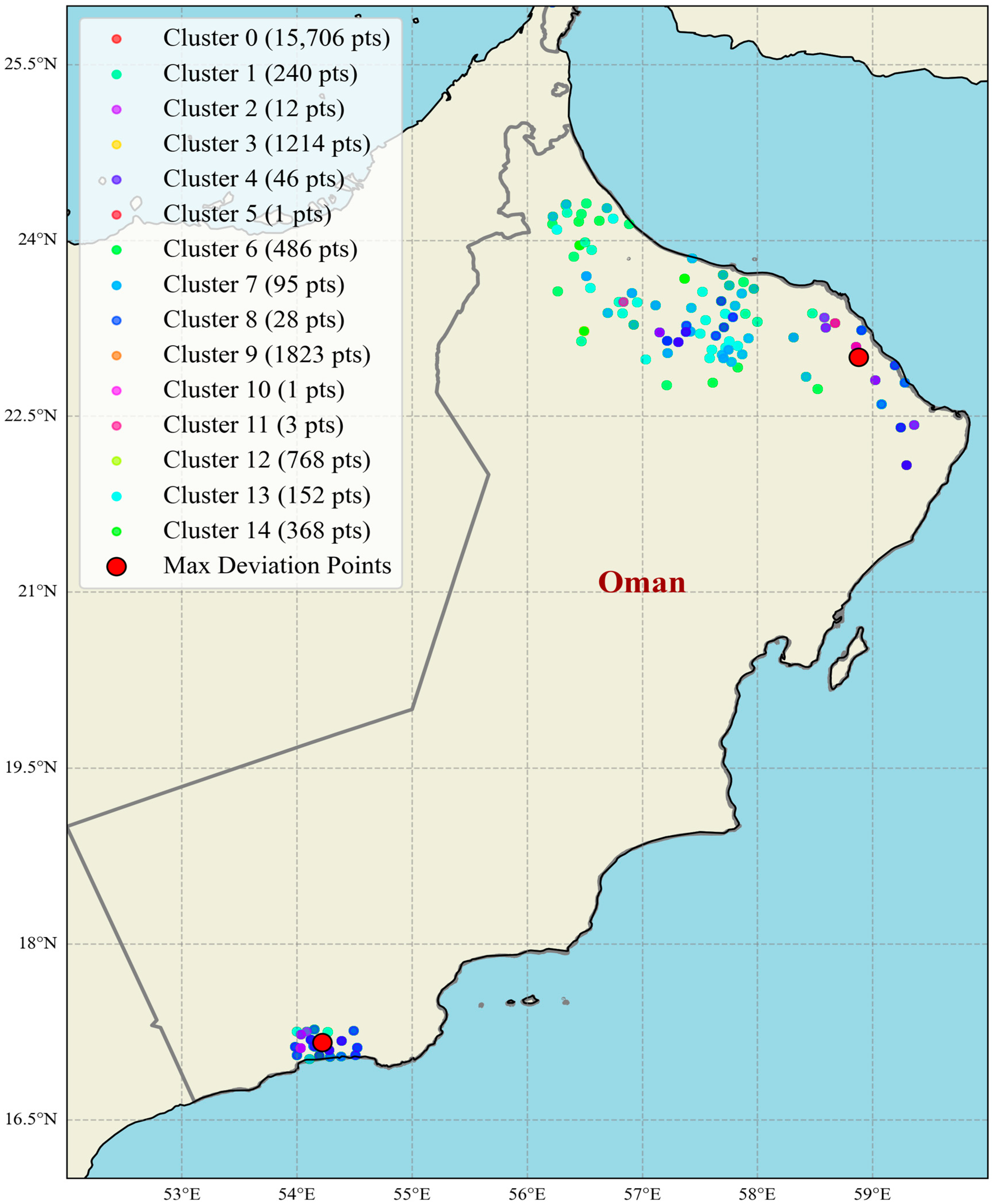

| Metric | Before Quantile Mapping | After Quantile Mapping |
|---|---|---|
| NSE | −0.0657 | 0.9825 |
| KGE | −0.4545 | 0.9910 |
| RMSE | 25.5617 | 3.2741 |
| Bias | −0.9565 | 0.0011 |
| Cluster | Number of Points | Mean Latitude | Mean Longitude |
|---|---|---|---|
| 0 | 15,706 | 22.270032 | 56.776141 |
| 1 | 240 | 22.062998 | 56.699072 |
| 2 | 12 | 20.603757 | 56.703053 |
| 3 | 1214 | 22.460950 | 56.852738 |
| 4 | 46 | 19.988297 | 55.847929 |
| 5 | 1 | 17.160248 | 54.220527 |
| 6 | 486 | 22.400769 | 56.883734 |
| 7 | 95 | 21.620749 | 56.416030 |
| 8 | 28 | 20.165147 | 56.076964 |
| 9 | 1823 | 22.552042 | 56.877945 |
| 10 | 1 | 23.001329 | 58.878170 |
| 11 | 3 | 23.287664 | 58.121844 |
| 12 | 768 | 22.424523 | 56.902481 |
| 13 | 152 | 22.037893 | 56.631199 |
| 14 | 368 | 22.082265 | 56.744165 |
| Number of Clusters | NSE Improvement Rate | KGE Improvement Rate | RMSE Improvement Rate | Bias Improvement Rate |
|---|---|---|---|---|
| 1 | 0.062821 | 0.028291 | −0.978487 | −1.699454 × 10−4 |
| 2 | 0.039924 | 0.018302 | −0.730568 | −1.465856 × 10−3 |
| 3 | 0.035919 | 0.017085 | −0.833730 | −1.800803 × 10−4 |
| 4 | 0.011957 | 0.006121 | −0.365616 | −3.465341 × 10−4 |
| 5 | 0.004621 | 0.002058 | −0.169983 | 2.052146 × 10−4 |
| 6 | 0.002708 | 0.001339 | −0.113965 | −1.036667 × 10−4 |
| 7 | 0.000522 | 0.000013 | −0.023806 | 4.480378 × 10−5 |
| 8 | 0.001084 | 0.000451 | −0.052323 | −1.143269 × 10−6 |
| 9 | 0.000838 | 0.000335 | −0.043902 | −1.577021 × 10−19 |
| 10 | 0.001729 | 0.001348 | −0.106747 | −2.375115 × 10−4 |
| 11 | 0.000415 | 0.000205 | −0.030815 | −3.113685 × 10−6 |
| 12 | 0.000328 | 0.000162 | −0.026878 | −1.171961 × 10−5 |
| 13 | 0.000204 | 0.000096 | −0.018308 | 8.775361 × 10−6 |
| 14 | 0.000091 | 0.000039 | −0.008701 | 4.094139 × 10−6 |
Disclaimer/Publisher’s Note: The statements, opinions and data contained in all publications are solely those of the individual author(s) and contributor(s) and not of MDPI and/or the editor(s). MDPI and/or the editor(s) disclaim responsibility for any injury to people or property resulting from any ideas, methods, instructions or products referred to in the content. |
© 2025 by the authors. Licensee MDPI, Basel, Switzerland. This article is an open access article distributed under the terms and conditions of the Creative Commons Attribution (CC BY) license (https://creativecommons.org/licenses/by/4.0/).
Share and Cite
Al-Rawas, G.; Nikoo, M.R.; Sadra, N.; Mousavi, F. Integrated Quantile Mapping and Spatial Clustering for Robust Bias Correction of Satellite Precipitation in Data-Sparse Regions. Sustainability 2025, 17, 8321. https://doi.org/10.3390/su17188321
Al-Rawas G, Nikoo MR, Sadra N, Mousavi F. Integrated Quantile Mapping and Spatial Clustering for Robust Bias Correction of Satellite Precipitation in Data-Sparse Regions. Sustainability. 2025; 17(18):8321. https://doi.org/10.3390/su17188321
Chicago/Turabian StyleAl-Rawas, Ghazi, Mohammad Reza Nikoo, Nasim Sadra, and Farid Mousavi. 2025. "Integrated Quantile Mapping and Spatial Clustering for Robust Bias Correction of Satellite Precipitation in Data-Sparse Regions" Sustainability 17, no. 18: 8321. https://doi.org/10.3390/su17188321
APA StyleAl-Rawas, G., Nikoo, M. R., Sadra, N., & Mousavi, F. (2025). Integrated Quantile Mapping and Spatial Clustering for Robust Bias Correction of Satellite Precipitation in Data-Sparse Regions. Sustainability, 17(18), 8321. https://doi.org/10.3390/su17188321







